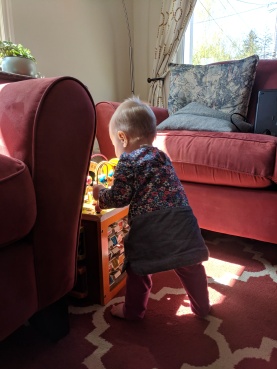One toy with “Grow-With-Me” versatility is the B. Toys Zany Zoo activity cube.
Although the age recommendation from the manufacturer is 1 to 3 years old, we have seen a plethora of possibilities before age one (with supervision) since receiving it as a gift for my daughter when was just five months old.
The Zany Zoo features loopty-loo tracks with beads and mobile animals on top, as well four sides which offer opportunities for gross and fine motor development, color and letter recognition, matching, concept development (open/close, front/back, up/down, fast/slow). It is solid wood, painted (with lead-free paint) in beautiful, appealing colors, and retails at $59.99. As far as baby and toddler toys go, that can seem like a high price, but with the longevity it offers I would argue it is well worth it.
Here is how I have seen the Zany Zoo activity cube at work for different stages of development.
Infant play at five to six months:

My daughter loved doing tummy time in front of the side featuring several rows of wooden tiles which spin around. Each tile is painted with a letter of the alphabet, an animal that starts with that letter, and the name of the animal.
I love that some of them are not your typical alphabet book animals, such as “Carp” and “Narwhal.” She would lie in front of the toy, reaching out to spin the tiles and enjoying the cascading sound of several rows spinning at once.
As soon as she could sit up, she loved reaching for the ducks and rhinos on top of the cube, as well as knocking down the “racing animals” which zig-zag down paths cut in one side and opening and closing the doors hiding colorful animals.
Seven to ten months:
All other interest subsided in the wake of wanting to pull up. The loopty-loo bars on top of this toy offered the perfect point to grab and pull up on. (Disclaimer: this toy is not meant to act as a walker and does require an adult holding the toy down to keep it from tipping over in this case.) See the first photo in this post as an example.
Ten to twelve months:

As children can stand and cruise around, this toy offers activities right at standing level (which is about all they want to do as they figure that out!).
As we head into the actual recommended ages for this toy, I am excited to continue introducing colors, letters, animal names, and early learning concepts to my child.
This toy is also so well-made and intentionally designed that I enjoy having it out in my living room so it is available for play and exploration. It meets all the criteria I look for in a toy and offers more learning and possibilities than I originally anticipated!
Now that’s a win!

Aimee Ray, co-blogger for Parenting by Faith, is an early childhood educator turned mama in Seattle, WA, with a passion for building a strong foundation for little hearts and minds. She hopes to foster the joy of early learning in young children by supporting intentional play.





 I’m Laurie’s daughter, and a new co-blogger for her Parenting by Faith blog. I am an early childhood educator turned mama, with a passion for building a strong foundation for little hearts and minds. It is such a joy to see children learn about the world around them starting in infancy and I hope to foster that joy in others by supporting intentional play.
I’m Laurie’s daughter, and a new co-blogger for her Parenting by Faith blog. I am an early childhood educator turned mama, with a passion for building a strong foundation for little hearts and minds. It is such a joy to see children learn about the world around them starting in infancy and I hope to foster that joy in others by supporting intentional play.